Excerpts from Jim Conrad's
Naturalist Newsletter
Entry dated August 7, 2023, issued from near Tequisquiapan, elevation about 1,900m (6200 ft), Querétaro state, MÉXICO
(~N20.57°, ~W99.89°)
SMALL JERUSALEM CRICKET
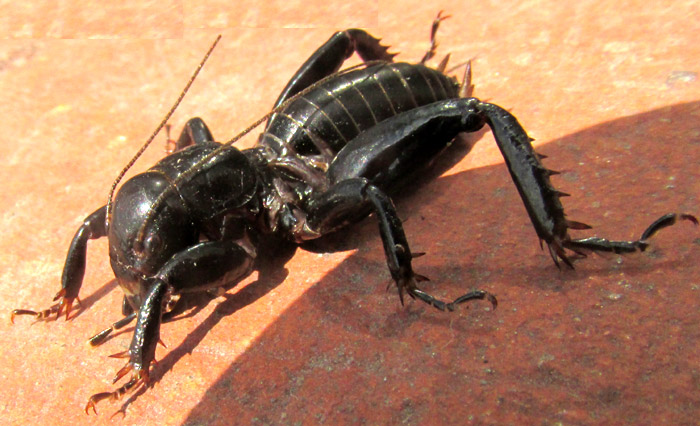
The above was found dead early one morning, floating in a dog's water bowl, outside the door of a house at the edge of a small village. The house was enclosed by a high stone wall, with the open area between the house and the wall covered with tiles and concrete. In short, one wondered where the creature came from. The area's long-enduring drought can explain its presence in the water bowl. However, the legs' sturdy spines look adapted for digging in the ground, and the small, hardly noticeable compound eyes further suggest an underground life. If this individual emerged from a burrow to search water, it came a long way, over a stone wall, to find it.
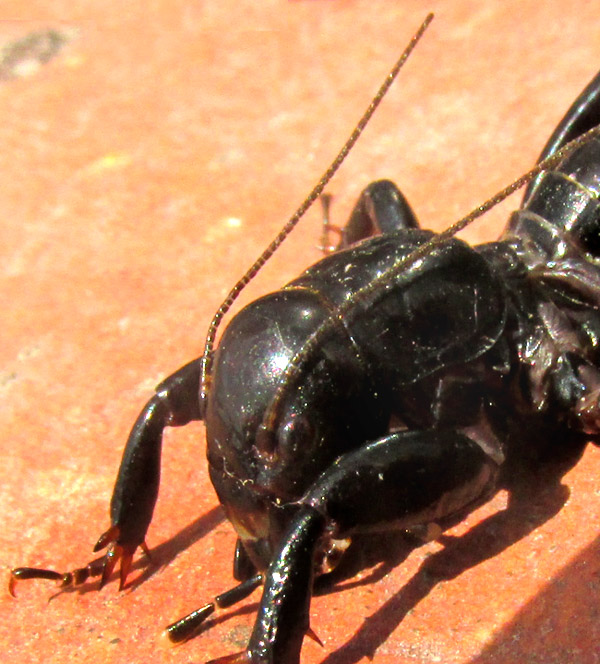
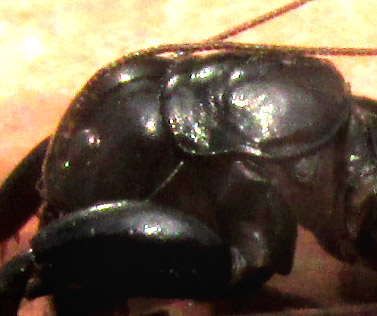
It looks like a cricket, but its head is inordinately large and there's no indication of wings. Wings would arise immediately behind the shell-like hump behind the big head, the pronotum, but there's not even a hint of wing buds, which an immature stage would display. On commonly seen crickets, the pronotum doesn't bulge upward so notably, and there's no constriction in the body behind it, better seen at the right. Also, this insect's antennae are shorter than most crickets'.
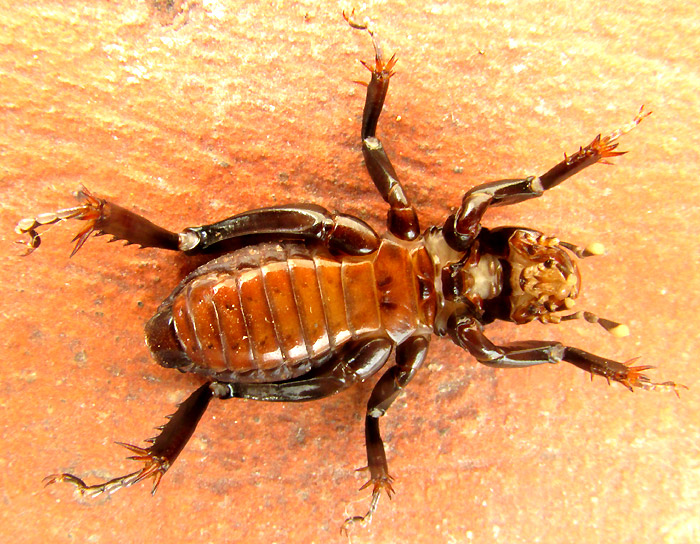
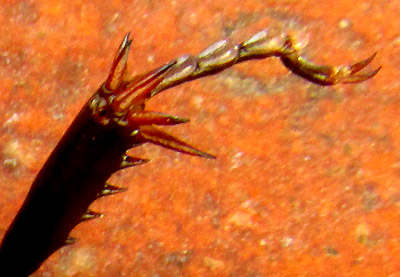
The bottom is pale. Especially at the tips of the middle legs, notice the slender appendages, closer seen at the left. Those are tarsi, segmented into tarsomeres, and they're tipped with tarsal claws. Other insects have tarsi, but it's unusual that these are so small and flimsy looking compared to the clublike tibia and spiky tibial claws closer to the body. If this is really a ground-burrower, what's the advantage of such delicate tarsi?

The mouthparts are typical for chewing insects such as crickets and grasshoppers. Above, the longer, antenna-like items are the maxillary palps, which help feel and sense what's around their mouths. The similar, shorter things are labial palps, serving the same function but more focused on what's closest to the mouthparts.
We've met similar insects before, in California's Sierra Nevada foothills, sheltering beneath heaped-up cut grass. That was a Jerusalem Cricket, or Potato Bug, Ammopelmatus fuscus. In our semiarid region of upland central Mexico only one Stenopelmatus species has been documented, and its pictures match our cricket perfectly. It's STENOPELMATUS MINOR, known in English as the Small Jerusalem Cricket, endemic just to the uplands of central and southern Mexico.
Though pictures of Small Jerusalem Crickets are plentiful on the Internet, there's hardly anything about their life history. However, much is known about the California species, and probably ours has similar habits, especially since its general anatomy is so similar. The California ones do indeed live in burrows in shallow soil, often beneath rocks or logs. They're known to roam about during late afternoons and evenings, and frequently end up drowned in swimming pools and ponds. They stray through open doors and turn up in garages and homes.
They're wingless, have poor eyesight, and don't chirp like common crickets. They find mates by "drumming" their plump abdomens on the ground. Mainly they eat decaying organic matter, roots and tubers, but also other insects, and one another. They aren't venomous, don't sting, but they can bite if roughly handled.
Are Jerusalem Crickets "real" crickets? First of all, in the big scheme of taxonomy, when you consider all the different forms of the huge order of Orthoptera, the boundaries between what we think of as grasshoppers, crickets, katydids and the like are blurred; in-between kinds of beings exist. Jerusalem Crickets have their own family, the Stenopelmatidae, while the species most English speakers think of as "real" crickets have their own family. But there are also creatures like camel crickets, hump-winged crickets, and king crickets, each with their own families.
Also, Jerusalem Cricket taxonomy is in a state of flux. In fact, our Small Jerusalem Cricket's name, Stenopelmatus minor, currently is regarded as "accepted" but also a nomen dubium -- doubtfully correct but no better name is available. At the GBIF site, a discussion on the name Stenopelmatus minor admits that Mexico's diversity of small, black Stenopelmatus species is simply unknown, and that "This situation will be unresolvable without the behavioral information of hop vs no hop, and drumming pattern." Apparently some look-alike species can hop while others can't, and when they drum with their big abdomens the drumming pattern differs from species to species. Of course genetic studies could provide insights, but they still cost too much and too many taxa need analyzing.
Whatever the case, I regretted that ours turned up dead in a dog's water bowl, and still wonder how he got over the walls.